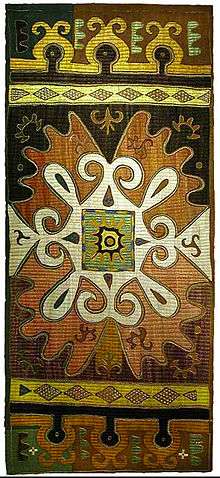Running stitch
The running stitch or straight stitch is the basic stitch in hand-sewing and embroidery, on which all other forms of sewing are based. The stitch is worked by passing the needle in and out of the fabric at a regular distance[1]. The needle is always pushed through both layers of cloth starting on the side it is on and ending on the other side. A running stitch runs through the fabric[2]. Running stitches are most often not visible as they are used to close seams.[3]

Uses
Running stitches are used in hand-sewing and tailoring to sew basic seams, in hand patchwork to assemble pieces, and in quilting to hold the fabric layers and batting or wadding in place.[4] Loosely spaced rows of short running stitches are used to support padded satin stitch.

Running stitches are a component of many traditional embroidery styles, including kantha of India and Bangladesh, and Japanese sashiko quilting and other embroidery styles such as pattern darning and redwork.[5][1]
Related stitches
- Basting stitches, also called "tailor's tack", are long running stitches used to keep two pieces of fabric or trim aligned during final sewing, or to otherwise temporarily sew two pieces together.
- Darning stitches are closely spaced parallel rows of running stitches used to fill or reinforce worn areas of a textile, or as decoration.
- Holbein or double-running stitches have a second row of running stitches worked in a reverse direction in between the stitches of the first pass, to make a solid line of stitching.
- Double darning stitches are closely spaced (but not overlapping) rows of Holbein stitches.[6]
See also
Notes
- "Running Stitch". Sarah's Hand Embroidery Tutorials. Retrieved 2020-05-11.
- How to do the Running Stitch, retrieved 2020-05-31
- Reader's Digest Complete Guide to Needlework. The Reader's Digest Association, Inc. (July 25th 2008). ISBN 0-89577-059-8, p. 46
- Complete Guide to Needlework, p. 200, 220
- Gillow, John, and Bryan Sentance: World Textiles, Bulfinch Press/Little, Brown, 1999, ISBN 0-8212-2621-5, p. 172-173
- Complete Guide to Needlework, p. 46-47
Further reading
| Wikimedia Commons has media related to embroidery stitches. |
- Caulfield, S.F.A., and B.C. Saward, The Dictionary of Needlework, 1885.
- Enthoven, jacqueline: The Creative Stitches of Embroidery, Van Norstrand Rheinhold, 1964, ISBN 0-442-22318-8
- Gillow, John, and Bryan Sentance: World Textiles, Bulfinch Press/Little, Brown, 1999, ISBN 0-8212-2621-5
- Reader's Digest, Complete Guide to Needlework. The Reader's Digest Association, Inc. (March 1992). ISBN 0-89577-059-8
- Sarah's Hand Embroidery Tutorials.



